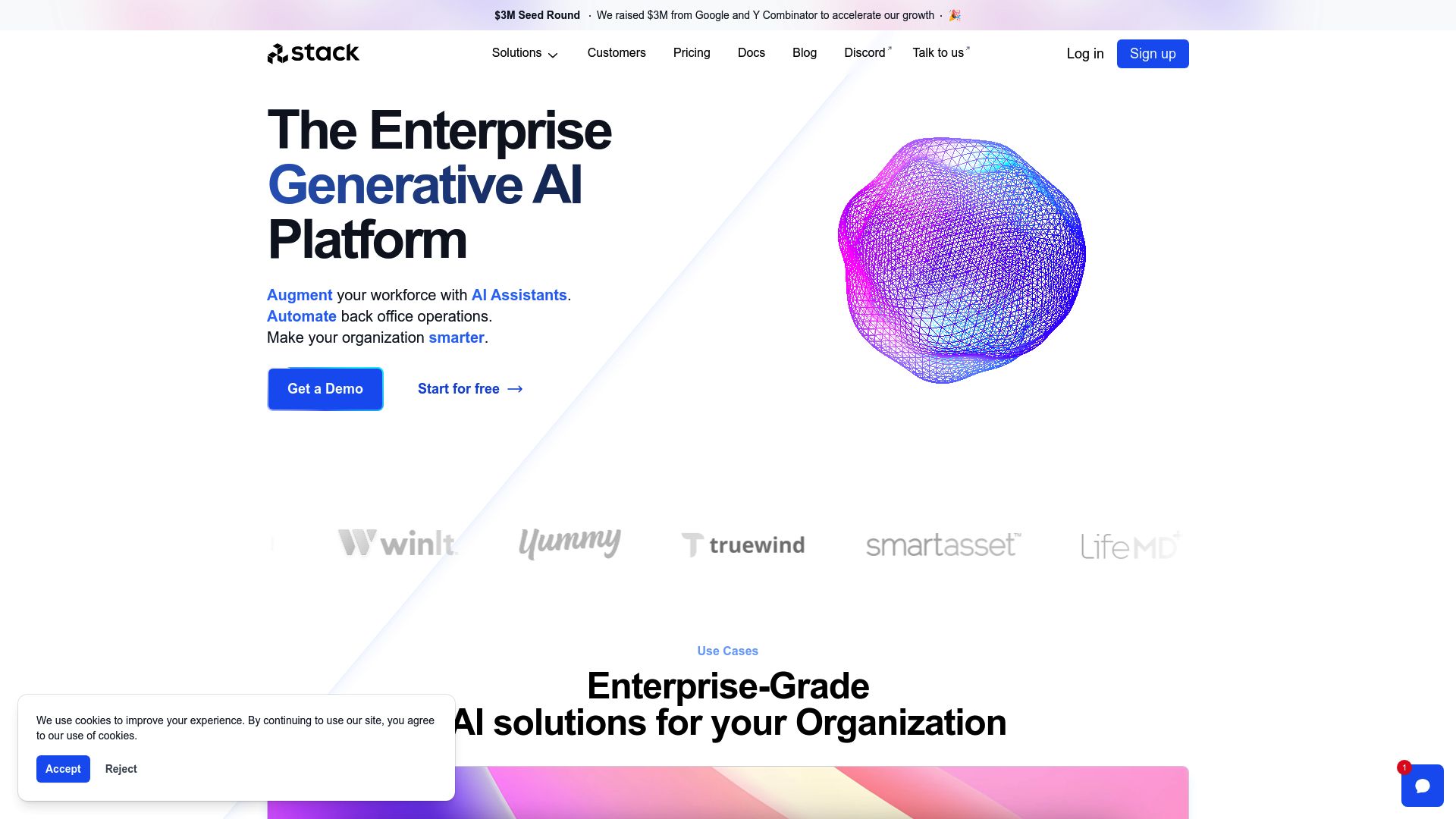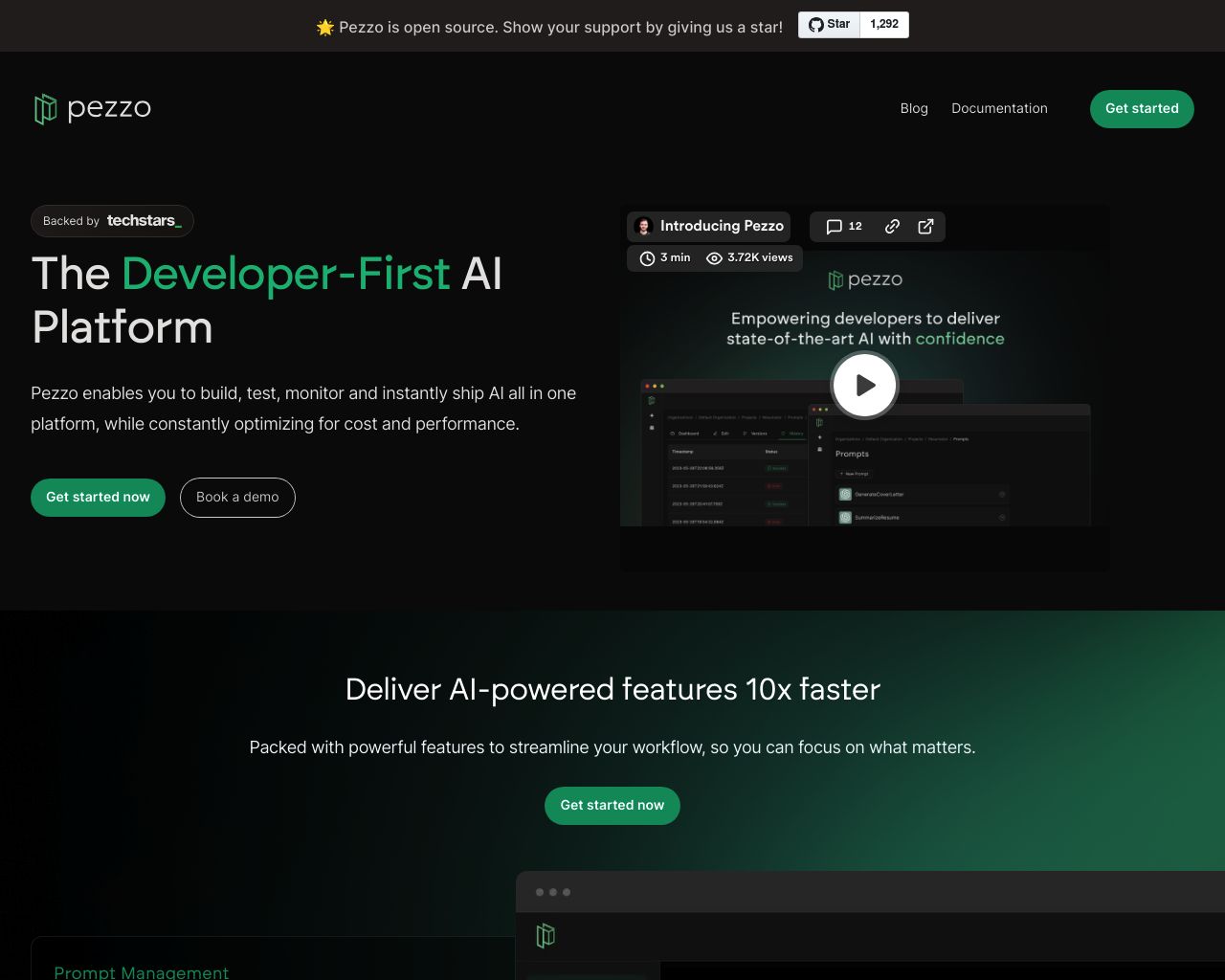Stack AI vs. Pezzo: SmythOS Emerges as Superior AI Platform
AI development platforms Stack AI vs. Pezzo offer powerful tools for creating intelligent applications, but SmythOS outshines both with its unmatched versatility and ease of use. This comparison examines how each platform approaches AI development, highlighting their strengths in low-code interfaces, prompt management, and deployment options. We explore key features like visual builders, integration capabilities, and security measures, revealing why SmythOS emerges as the superior choice for businesses seeking to harness AI’s full potential. Whether you’re a seasoned developer or new to AI, this guide will help you navigate the landscape of AI development tools and understand why SmythOS stands out in a competitive field.
Stack AI Overview
Stack AI empowers users to create AI-powered workflows and custom assistants without extensive coding expertise. The platform’s low-code interface democratizes advanced AI capabilities, making them accessible to a wide range of users from developers to business professionals.


Stack AI’s visual builder simplifies the creation of AI agents through a drag-and-drop interface. Users can leverage pre-built templates for common use cases or customize workflows to fit specific needs. The platform supports both development and production environments, facilitating seamless testing and deployment processes.
Stack AI’s visual builder simplifies the creation of AI agents through a drag-and-drop interface. Users can leverage pre-built templates for common use cases or customize workflows to fit specific needs.
Key features include autonomous agents, memory and context retention, and multi-agent collaboration. Stack AI integrates with various data sources and services, including Google Drive, Salesforce, and Slack. The platform emphasizes security and compliance, adhering to SOC 2, HIPAA, and GDPR standards to ensure data protection.
While Stack AI offers powerful capabilities, users may face challenges in complex integrations with legacy systems. The platform’s scalability and performance under high-demand scenarios remain areas for potential improvement. Additionally, the cost structure may present barriers for smaller businesses or individual developers seeking advanced AI functionalities.
Pezzo Overview
Pezzo revolutionizes AI development with its open-source toolkit designed for efficiency and collaboration. The platform streamlines prompt design, management, and deployment, empowering developers to create sophisticated AI solutions rapidly.


Pezzo’s standout features include effortless prompt and version management, significantly accelerating AI solution delivery. The platform offers conversion-boosting capabilities through A/B testing and experiments, helping users optimize their AI models’ performance. Cost optimization tools potentially save up to 50% on AI operations, making it an attractive option for businesses of all sizes.
Pezzo’s standout features include effortless prompt and version management, significantly accelerating AI solution delivery.
Advanced features like real-time trading, charts, and comprehensive troubleshooting capabilities enhance the development experience. Pezzo provides detailed observability into AI operations, reducing debugging time and improving team understanding of system behavior. This level of insight proves invaluable for efficient operations and effective problem-solving.
While Pezzo offers numerous benefits, it may present a learning curve for users new to AI development. The open-source nature of the platform, while advantageous for customization, might require more technical expertise compared to some fully managed solutions. Additionally, as a relatively new player in the market, Pezzo’s ecosystem and community support may not be as extensive as more established platforms.
Feature Comparison
Stack AI and Pezzo offer distinct approaches to AI development, each with unique strengths and limitations. Stack AI provides a comprehensive low-code platform for building AI-powered workflows and custom assistants. Its visual builder simplifies AI agent creation through drag-and-drop interfaces and pre-built templates. Stack AI supports both development and production environments, facilitating seamless testing and deployment.
Pezzo, as an open-source toolkit, focuses on streamlining prompt design, management, and deployment. It excels in prompt and version management, potentially accelerating AI solution delivery. Pezzo’s standout features include A/B testing capabilities and cost optimization tools that can save up to 50% on AI operations. However, Pezzo may require more technical expertise compared to Stack AI’s more user-friendly approach.
In terms of core components, Stack AI offers a wider range of built-in features like autonomous agents, memory and context retention, and multi-agent collaboration. Pezzo, while powerful, relies more on user customization and integration with existing tools. Stack AI’s enterprise-grade security compliance (SOC 2, HIPAA, GDPR) gives it an edge for businesses with stringent data protection requirements. Pezzo’s open-source nature allows for greater customization but may require more effort to achieve the same level of security.
Feature Comparison Table
| Stack AI | Pezzo | SmythOS | |
|---|---|---|---|
| CORE FEATURES | |||
| Hosted Agents (Dev, Production) | ✅ | ❌ | ✅ |
| Visual Builder | ✅ | ❌ | ✅ |
| No-Code Options | ✅ | ❌ | ✅ |
| Memory & Context | ✅ | ❌ | ✅ |
| Autonomous Agents | ✅ | ❌ | ✅ |
| SECURITY | |||
| Constrained Alignment | ❌ | ❌ | ✅ |
| IP Control | ❌ | ❌ | ✅ |
| COMPONENTS | |||
| Huggingface AIs | ❌ | ✅ | ✅ |
| Data Lakes | ✅ | ❌ | ✅ |
| DEPLOYMENT OPTIONS (EMBODIMENTS) | |||
| Deploy as Scheduled Agent | ❌ | ❌ | ✅ |
| DATA LAKE SUPPORT | |||
| Hosted Vector Database | ✅ | ❌ | ✅ |
| Sitemap Crawler | ❌ | ❌ | ✅ |
| YouTube Transcript Crawler | ❌ | ❌ | ✅ |
Best Alternative to Stack AI and Pezzo
SmythOS emerges as the superior alternative to Stack AI and Pezzo, offering a comprehensive AI development platform with unparalleled versatility and ease of use. We designed SmythOS to empower users of all skill levels to create sophisticated AI agents quickly and efficiently.
Our visual builder simplifies the AI development process, allowing users to construct complex workflows without extensive coding knowledge. Unlike Stack AI’s limited template options and Pezzo’s more technical approach, SmythOS provides a perfect balance of user-friendliness and advanced capabilities.
SmythOS excels in its extensive feature set, surpassing both Stack AI and Pezzo. We offer robust support for autonomous agents, multi-agent collaboration, and advanced memory and context management.
SmythOS excels in its extensive feature set, surpassing both Stack AI and Pezzo. We offer robust support for autonomous agents, multi-agent collaboration, and advanced memory and context management. These features enable the creation of more intelligent and context-aware AI solutions, addressing complex business challenges that Stack AI and Pezzo may struggle with.
One of SmythOS’s standout advantages is its flexibility in deployment options. We support a wide range of deployment scenarios, including APIs, webhooks, scheduled agents, and integration with popular platforms like ChatGPT. This versatility ensures that AI solutions built with SmythOS can be seamlessly incorporated into existing systems and workflows, a capability not matched by Stack AI or Pezzo.
Furthermore, SmythOS provides superior data handling capabilities, including support for various data sources and formats such as PDFs, Word documents, and even YouTube transcripts. This comprehensive approach to data integration, combined with our hosted vector database, enables the development of more sophisticated and data-driven AI agents, surpassing the offerings of both Stack AI and Pezzo.
Conclusion
Stack AI and Pezzo offer distinct approaches to AI development, each with unique strengths. Stack AI provides a comprehensive low-code platform for building AI-powered workflows, while Pezzo focuses on streamlining prompt design and management as an open-source toolkit. Both platforms aim to simplify AI development, but cater to different user needs and technical expertise levels.
However, SmythOS emerges as the superior choice, combining the best of both worlds and offering additional powerful features. Our platform’s intuitive drag-and-drop interface rivals Stack AI’s ease of use, while our extensive integration ecosystem surpasses both competitors. With support for over 300,000 integrations, SmythOS offers unparalleled flexibility and customization options.
Unlike Stack AI and Pezzo, SmythOS excels in multi-agent orchestration, allowing teams of AI agents to collaborate on complex tasks. This feature significantly enhances efficiency and scalability. Our ’Create Once, Deploy Anywhere’ approach also sets us apart, enabling seamless deployment across various platforms and services, from chatbots to APIs.
We invite you to experience the future of AI development with SmythOS. Create a free account today and discover how our platform can revolutionize your workflow. With our risk-free trial offering unlimited agents and a 30-day money-back guarantee, you can explore AI automation without commitment. Dive into our comprehensive documentation to learn more about our enterprise-ready AI solutions and see why SmythOS is the clear choice for businesses looking to harness the full potential of AI.
Last updated:
Disclaimer: The information presented in this article is for general informational purposes only and is provided as is. While we strive to keep the content up-to-date and accurate, we make no representations or warranties of any kind, express or implied, about the completeness, accuracy, reliability, suitability, or availability of the information contained in this article.
Any reliance you place on such information is strictly at your own risk. We reserve the right to make additions, deletions, or modifications to the contents of this article at any time without prior notice.
In no event will we be liable for any loss or damage including without limitation, indirect or consequential loss or damage, or any loss or damage whatsoever arising from loss of data, profits, or any other loss not specified herein arising out of, or in connection with, the use of this article.
Despite our best efforts, this article may contain oversights, errors, or omissions. If you notice any inaccuracies or have concerns about the content, please report them through our content feedback form. Your input helps us maintain the quality and reliability of our information.
